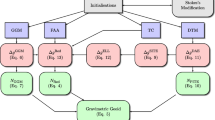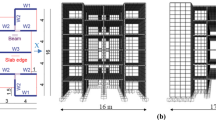Abstract
In this manuscript we present a nonlinear site amplification model for ground-motion prediction equations (GMPEs) in Japan, using a site period-based site class and a site impedance ratio as site parameters. We used a large number of shear-wave velocity profiles from the Kiban-Kyoshin network (KiK-net) and the Kyoshin network (K-NET) to construct the one-dimensional (1D) numerical models. The strong-motion records from rock-sites in Japan with different earthquake categories and taken from the Pacific Earthquake Engineering Research Center dataset were used in this study. We fit a set of 1D site amplification models using the spectral amplification ratios derived from 1D equivalent linear analyses. Parameters of site impedance ratios for both linear and nonlinear site response were included in the 1D model. The 1D model could be implemented into GMPEs using a new proposed adjustment method. The adjusted site amplification ratios retain the nonlinear characteristics of the 1D model for strong motions and match the linear amplification ratio in GMPE for weak motions. The nonlinearity of the present site model is reasonably similar to that of the historical models, and the present site model could satisfactorily capture the nonlinear site response in empirical data.
Similar content being viewed by others
References
Abrahamson NA, Silva WJ and Kamai R (2014), “Summary of the ASK14 Ground Motion Relation for Active Crustal Regions,” Earthquake Spectra, 30(3): 1025–1056.
Abrahamson NA and Youngs RR (1992), “A Stable Algorithm for Regression Analysis Using the Random Effect Model,” Bulletin of the Seismological Society of America, 82(1): 505–510.
Asimaki D and Shi J (2017), SeismoSoil User Manual, v1.3, California Institute of Technology, pp. 1–35.
Bazzurro P and Cornell CA (2004), “Ground Motion Amplification in Nonlinear Soil Sites with Uncertain Properties,” Bulletin of the Seismological Society of America, 94(6): 2090–2109.
Boore DM, Stewart JP, Seyhan E and Atkinson GM (2014), “NGA-West2 Equations for Predicting PGA, PGV, and 5% Damped PSA for Shallow Crustal Earthquakes,” Earthquake Spectra, 30(3): 1057–1086.
Campbell KW and Bozorgnia Y (2014), “NGA-West2 Ground Motion Model for the Average Horizontal Components of PGA, PGV, and 5% Damped Linear Acceleration Response Spectra,” Earthquake Spectra, 30(3): 1087–1115.
Carlton B and Tokimatsu K (2016), “Comparison of Equivalent Linear and Nonlinear Site Response Analysis Results and Model to Estimate Maximum Shear Strain,” Earthquake Spectra, 32(3): 1867–1887.
Chiou BS and Youngs RR (2014), “Update of the Chiou and Youngs NGA Model for the Average Horizontal Component of Peak Ground Motion and Response Spectra,” Earthquake Spectra, 30(3): 1117–1153.
Choi Y and Stewart JP (2005), “Nonlinear Site Amplification as Function of 30 m Shear Wave Velocity,” Earthquake Spectra, 21(1): 1–30.
Darendeli MB (2001), “Development of a New Family of Normalized Modulus Reduction and Material Damping Curves,” PhD Thesis, University of Texas at Austin.
FEMA 368/369 (2000), The 2000 NEHRP Recommended Provisions for New Buildings and Other Structures, Part I: Provisions and Part II: Commentary, Building Seismic Safety Council (BSSC), Washington D.C., USA, 39–41.
Griffiths SC, Cox BR and Rathje EM (2016), “Challenges Associated with Site Response Analyses for Soft Soils Subjected to High-Intensity Input Ground Motions,” Soil Dynamics and Earthquake Engineering, 85: 1–10.
Harmon J, Hashash YMA, Stewart JP, Rathje EM, Campbell KW, Silva WJ, Xu B, Musgrove M, and Ilhan O (2019), “Site Amplification Functions for Central and Eastern North America — Part I: Simulation Data Set Development,” Earthquake Spectra, 35(2): 787–814.
Kaklamanos J, Baise LG, Thompson EM and Dorfmann L (2015), “Comparison of 1D Linear, Equivalent-Linear, and Nonlinear Site Response Models at Six KiKnet Validation Sites,” Soil Dynamics and Earthquake Engineering, 69: 207–219.
Kamai R, Abrahamson NA and Silva WJ (2014), “Nonlinear Horizontal Site Amplification for Constraining the NGA-West2 GMPEs,” Earthquake Spectra, 30(3): 1223–1240.
Kim B, Hashash YMA, Stewart JP, Rathje EM, Harmon JA, Musgrove MI, Campbell KW and Silva WJ (2016), “Relative Differences Between Nonlinear and Equivalent-Linear 1D Site Response Analyses,” Earthquake Spectra, 32(3): 1845–1865.
Kondner RL and Zelasko JS (1963), “A Hyperbolic Stress-Strain Formulation of Sands,” Proceeding 2nd Pan-American Conference on Soil Mechanics and Foundation Engineering, Brazilian Association of Soil Mechanics, Silo Paulo, Brazil, 289–324.
Ladd CC (1991), “Stability Evaluation During Staged Construction: The 22nd Terzaghi Lecture,” Journal of Geotechnical Engineering, 117(4): 540–615.
Liu J, Zhang X, Cao Z, Han B and Yang S (2019), “Analytical Solution for Vertical Site Response Analysis and Its Validation,” Earthquake Engineering and Engineering Vibration, 18(1): 53–60.
Matasovic N and Vucetic M (1993), “Cyclic Characterization of Liquefiable Sands,” Journal of Geotechnical Engineering, 119(11): 1805–1822.
McCarron W, Lawrence J, Werner R, Germaine J and Cauble D (1995), “Cyclic Direct Simple Shear Testing of a Beaufort Sea Clay,” Canadian Geotechnical Journal, 32(4): 584–600.
Régnier J, Cadet H, Bonilla L, Bertand E and Semblat JF (2013), “Assessing Nonlinear Behavior of Soil in Seismic Site Response: Statistical Analysis on KiKnet Strong Motion Data,” Bulletin of the Seismological Society of America, 103(3): 1750–1770.
Sandıkkaya MA, Akkar S and Bard PY (2013), “A Nonlinear Site Amplification Model for the Next Pan-European Ground-Motion Prediction Equations,” Bulletin of the Seismological Society of America, 103(1): 19–32.
Schnabel PB, Lysmer J, Seed HB (1972), “SHAKE: A Computer Program for Earthquake Response Analysis of Horizontally Layered Sites,” Report No. UCB/EERC-72/12, Earthquake Engineering Research Center, University of California Berkeley, CA, USA, 1–114.
Seyhan E and Stewart JP (2014), “Semi-Empirical Nonlinear Site Amplification from NGA-West2 Data and Simulations,” Earthquake Spectra, 30(3): 1241–1256.
Shi J (2019), “Improving Site Response Analysis for Earthquake Ground Motion Modeling,” PhD Thesis, California Institute of Technology.
Shi J and Asimaki D (2017), “From Stiffness to Strength: Formulation and Validation of a Hybrid Hyperbolic Nonlinear Soil Model for Site-Response Analyses,” Bulletin of the Seismological Society of America, 107(3): 1336–1355.
Stafford JP, Rodriguez-Marek A, Edwards B, Kruiver PP and Bommer JJ (2017), “Scenario Dependence of Linear Site-Effect Factors for Short-Period Response Spectral Ordinates,” Bulletin of the Seismological Society of America, 107(6): 2859–2872.
Stewart JP, Afshari K and Hashash YMA (2014), “Guidelines for Performing Hazard-Consistent 1D Ground Response Analysis for Ground Motion Prediction,” PEER Report No. 2014/16, Pacific Earthquake Engineering Research Center, University of California Berkeley, CA, USA, 1–152.
Thompson EM, Baise LG, Tanaka Y and Kayen RE (2012), “A Taxonomy of Site Response Complexity,” Soil Dynamics and Earthquake Engineering, 41: 32–43.
Toro G (1995), “Probabilistic Models of Site Velocity Profiles for Generic and Site-Specific Ground-Motion Amplification Studies,” Technical Report No. 779574, Brookhaven National Laboratory, Upton, NY, USA.
Walling M, Silva W and Abrahamson N (2008), “Nonlinear Site Amplification Factors for Constraining the NGA Models,” Earthquake Spectra, 24(1): 243–255.
Yee E, Stewart JP and Tokimatsu K (2013), “Elastic and Large-Strain Nonlinear Seismic Site Response from Analysis of Vertical Array Recordings,” Journal of Geotechnical and Geoenvironmental Engineering, 139(10): 1789–1801.
Zhang J and Zhao JX (2009), “Response Spectral Amplification Ratios from 1- and 2-Dimensional Nonlinear Soil Site Models,” Soil Dynamics and Earthquake Engineering, 29: 563–573.
Zhao JX, Hu J, Jiang F, Zhou J, Zhang Y, An X, Lu M and Rhoades DA (2015a), “Nonlinear Site Models Derived from 1D Analyses for Ground-Motion Prediction Equations Using Site Class as the Site Parameter,” Bulletin of the Seismological Society of America, 105(4): 2010–2022.
Zhao JX, Jiang F, Shi P, Xing H, Huang H, Hou R, Zhang Y, Yu P, Lan X, Rhoades DA, Somerville PG, Irikura K and Fukushima Y (2016c), “Ground-Motion Prediction Equations for Subduction Slab Earthquakes in Japan Using Site Class and Simple Geometric Attenuation Functions,” Bulletin of the Seismological Society of America, 106(4): 1535–1551.
Zhao JX, Liang X, Jiang F, Xing H, Zhu M, Hou R, Zhang Y, Lan X, Rhoades DA, Irikura K, Fukushima Y and Somerville PG (2016b), “Ground-Motion Prediction Equations for Subduction Interface Earthquakes in Japan Using Site Class and Simple Geometric Attenuation Functions,” Bulletin of the Seismological Society of America, 106(4): 1518–1534.
Zhao JX and Xu H (2013), “A Comparison of VS30 and Site Period as Site Effect Parameters in Response Spectral Ground-Motion Prediction Equations,” Bulletin of the Seismological Society of America, 103(1): 1–18.
Zhao JX and Zhang J (2010), “Side-Effect of Using Response Spectral Amplification Ratios for Soft Soil Sites: Earthquake Source-Type Dependent Amplification Ratios,” Soil Dynamics and Earthquake Engineering, 30(4): 258–269.
Zhao JX, Zhou S, Gao P, Long T, Zhang Y, Thio HK, Lu M and Rhoades DA (2015b), “An Earthquake Classification Scheme for Ground-Motion Prediction Equations in Japan,” Bulletin of the Seismological Society of America, 105(5): 2750–2763.
Zhao JX, Zhou S, Zhou J, Zhao C, Zhang H, Zhang Y, Gao P, Lan X, Rhoades D, Fukushima Y, Somerville PG and Irikura K (2016a), “Ground-Motion Prediction Equations for Shallow Crustal and Upper Mantle Earthquakes in Japan Using Site Class and Simple Geometric Attenuation Functions,” Bulletin of the Seismological Society of America, 106(4): 1552–1569.
Acknowledgment
The work reported here is supported by research grant from the National Science Foundation of China (51578470). We gratefully acknowledge this support. An acknowledgement goes to Jian Shi from California Institute of Technology for his guidance on the hybrid-hyperbolic calibration of soil profiles used in this manuscript. The numerical calculations in this manuscript were performed on the supercomputing platform at Shandong Jianzhu University. In addition, we would like to acknowledge the National Research Institute for Earth Science and Disaster Prevention (NIED) for making the KiK-net and K-NET strong-motion data and velocity profiles freely available. In addition, we acknowledge the PEER centre for making their data freely available. We also appreciate the comments and suggestions provided by two anonymous reviewers.
Author information
Authors and Affiliations
Corresponding author
Additional information
Supported by
National Science Foundation of China under Grant No. 51578470
Rights and permissions
About this article
Cite this article
Hou, R., Zhao, J.X. A simulation-based nonlinear site amplification model for ground-motion prediction equations in Japan. Earthq. Eng. Eng. Vib. 20, 843–862 (2021). https://doi.org/10.1007/s11803-021-2058-z
Received:
Accepted:
Published:
Issue Date:
DOI: https://doi.org/10.1007/s11803-021-2058-z




